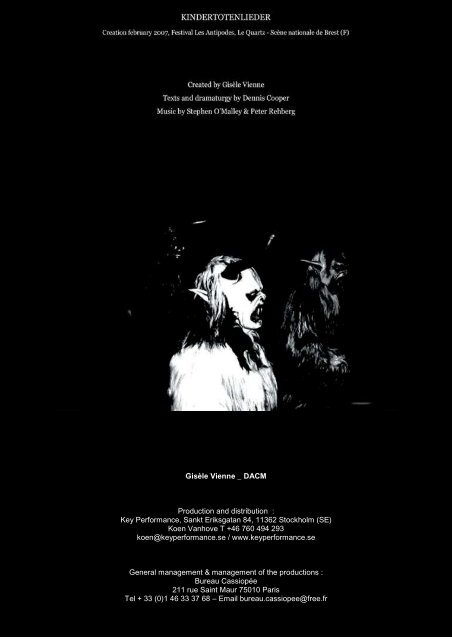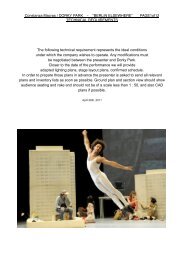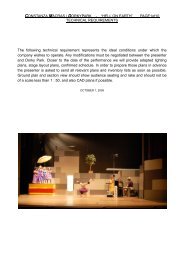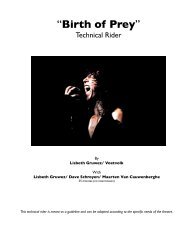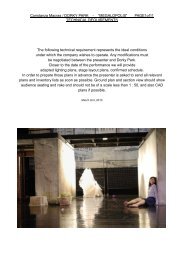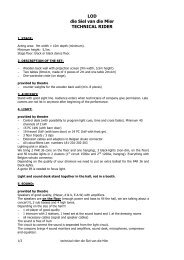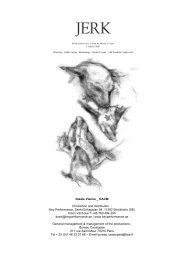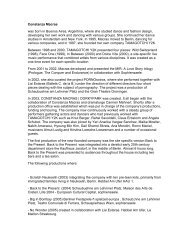Dossier - Key Performance
Dossier - Key Performance
Dossier - Key Performance
Create successful ePaper yourself
Turn your PDF publications into a flip-book with our unique Google optimized e-Paper software.
Gisèle Vienne _ DACM<br />
Production and distribution :<br />
<strong>Key</strong> <strong>Performance</strong>, Sankt Eriksgatan 84, 11362 Stockholm (SE)<br />
Koen Vanhove T +46 760 494 293<br />
koen@keyperformance.se / www.keyperformance.se<br />
General management & management of the productions :<br />
Bureau Cassiopée<br />
211 rue Saint Maur 75010 Paris<br />
Tel + 33 (0)1 46 33 37 68 – Email bureau.cassiopee@free.fr
Photo Antoine Masure
KINDERTOTENLIEDER<br />
Created by Gisèle Vienne<br />
Texts and dramaturgy by Dennis Cooper<br />
Music by Stephen O’Malley, Peter Rehberg / KTL<br />
Lights by Patrick Riou<br />
Conception robots by Alexandre Vienne<br />
Creation dolls by Raphaël Rubbens, Dorothéa Vienne-Pollak, Gisèle Vienne, assisted by Manuel<br />
Majastre<br />
Creation wood masks by Max Kössler<br />
Make-up by Rebecca Flores<br />
Hairdressing dolls by Yury Smirnov<br />
Texts traduced by Laurence Viallet<br />
Performed by and created in collaboration with Jonathan Capdevielle, Margrét Sara Gudjónsdóttir,<br />
Guillaume Marie, Anja Röttgerkamp or Anne Mousselet and Jonathan Schatz.<br />
With the help of the technical staff of the Quartz – Scene nationale de Brest:<br />
Technical director for the creation: Nicolas Minssen<br />
General manager: Laurent Matignon<br />
Stage manager: Christophe Le Bris or Christophe Tocanier<br />
Sound manager: Kenan Trevien<br />
Associate producer: DACM<br />
With the collaboration of the Quartz - Scene nationale de Brest (Gisèle Vienne associate artist from<br />
2007 to 2011)<br />
Coproduction : Le Quartz - Scène nationale de Brest, Centre, Chorégraphique National de Franche-<br />
Comté à Belfort dans le cadre de l’accueil-studio, Centre National de danse contemporaine d’Angers,<br />
Les Subsistances/ 2007/ Lyon<br />
With the support of the Drac Rhône-Alpes / Ministère de la Culture et de la communication, of the<br />
Région Rhône-Alpes, of the Conseil Général de l’Isère, of the town of Grenoble, of Dicream / Ministère<br />
de la Culture et de la Communication and of Etant donnés, The French-American Fund for the<br />
Performing Arts, a Program of FACE.<br />
With the support of the Centre Chorégraphique National de Montpellier Languedoc-Roussillon and<br />
Point Ephémère in Paris.<br />
Thanks to Les Ateliers de construction du Théâtre de Grenoble, Didier Boucher, Patric Chiha, Etnies,<br />
Simone Hoffmann, Antoine Masure, Minijy/Clara Rousseau, Séverine Péan, Sophie Metrich, le<br />
Théâtre de l’Odéon – Paris, Jose Enrique Ona Selfa for the costumes Loewe, Troubleyn/ Jan Fabre et<br />
Mark Geurden, Enrique Urrutia, Remy Vidal, Alexandre Vienne, Jean-Paul Vienne et Esther Welger-<br />
Barboza<br />
The company DACM is supported by the Drac Rhône-Alpes / Ministère de la culture et de la<br />
communication, Région Rhône-Alpes, and Institut français for international tour.
THE FRONTIERS BETWEEN REPRESENTATION AND REALITY<br />
A ceremony celebrating the horrifying: the march of the Perchten<br />
In order to tackle the issue of the shift from fiction to reality in the expression of fantasies, I have<br />
chosen to focus on one type of performance, the Austrian custom of the “Perchten”, which has gone<br />
through many precarious interpretations and even ideological hijackings.<br />
“Perchten” are creatures symbolising fears and anxieties. They appear each year at the<br />
beginning of January to chase evil demons away and to steal cursed souls as a punishment for the<br />
sins of their owners. This custom was alive and well throughout the country until the Inquisition, when<br />
representations of evil characters were outlawed. It then only survived in remote, hard-to-access<br />
mountainous areas of the Alps, where the Church could not easily impose its rules.<br />
Being of Austrian origin, I was able to witness the more recent evolution of the custom.<br />
Groups of mainly young people have tried from the early 90s onwards to bring this tradition back to<br />
life. The constant aesthetical evolution of the wooden masks and fur garments traditionally worn by the<br />
Perchten and designed to increase and renew the fear of the heart of men, means this custom<br />
remains alive and kicking today.<br />
Not only the aesthetics and codes of the ceremonial constitute elements of the play, but they also<br />
serve to feed the issues raised.<br />
A custom stripped of its ritualistic function<br />
Traces of this custom can be found in the 90s in the culture associated with certain types of music,<br />
such as black metal. The characters of the Perchten continue to serve their original purpose: scaring<br />
people - creating not only anxiety but also desire, and raising issues linked to our relationship with<br />
death.<br />
Some bands of young male musicians proudly claiming to be part of the black metal movement have,<br />
particularly in Norway, mixed this fantastical, traditional universe with reality. Acts of vandalism have<br />
been committed, their perpetrators thinking they would thus become part of a certain Germanic and<br />
Scandinavian heritage, and showing their confusion through the transposition of fantasies - which<br />
were originally part of a ritual - and through their out-of-context expression.<br />
I have taken these confused teenagers and the way they modified an old tradition, in order to examine<br />
the shift from fantasy to reality and the separation between fantasy and rational thinking. Although this<br />
issue was in previous work placed in an erotic and intimate setting, it now tackles our political<br />
behaviour and collective fantasies.
KINDERTOTENLIEDER, A REPRESENTATION OF SHIFTING FANTASIES<br />
When fantasies turn to reality<br />
Kindertotenlieder invites us to examine our own experience of the interpretation of reality and<br />
fantasy when faced with various registers of representation. It also leads us to question the expression<br />
of our own fantasies, fears and obsessions as well as our awareness of these elements, within their<br />
setting or within the hypotheses drawn from our imagination.<br />
On the stage, two teenagers within a group experience this confusion between fiction and reality. They<br />
are attending what seems to be a representation of a sort of concert for a funeral. The music is played<br />
by Stephen O’Malley and Peter Rehberg, among others, and it is a calm, dark and powerful score, like<br />
a bewitching version of black metal.<br />
Twenty-odd characters perform the various aspects of the play, from realism to obvious artificiality,<br />
through a sort of alphabet that links in one same flow body language, speech and a visual treatment of<br />
bodies (through make-up, masks, etc.) from the most schematic to the most realistic. Dancers,<br />
musicians and life-sized dolls all play a role, in an often-disturbed logic, and share the roles and words<br />
of the dead, the living, and the ghosts.<br />
The narrative grows in an environment favourable to the projection of fantasies, reminiscent of the<br />
dark romantic look of many alpine landscapes in winter. It allows for an interaction between romantic<br />
aesthetics and the aesthetics of the traditional custom of the Perchten. The above interaction often<br />
influences the aesthetics of black metal. Links and contradictions existing between these visual<br />
universes from different historical eras drive the aesthetics of this show.<br />
As the show progresses, the status of what is represented changes. The scene the two young boys<br />
and ourselves are watching represents the mourning ceremony for the funeral of one of them. The<br />
story then goes back to what lead the teenager to his death.<br />
The death itself is shown three times. First is the representation imagined by the murderer, then<br />
comes the fantasy representation of the victim, and finally what is presented to the public as the<br />
reality. This scene is strewn with elements hinting that these are the real facts. A crime has been<br />
recorded. The record is told to the audience, but the veracity of this document cannot be confirmed<br />
nor infirmed.<br />
Finally the play becomes more of a concert, but the theatrical aspect and the tricks used are<br />
exaggerated, offering a new possible interpretation of the whole play, i.e. if what preceded this<br />
moment does not belong to the performance of the same concert.<br />
The two teenagers are haunted by the idea of suicide and of their own death. Through the realisation,<br />
presented as ‘real’, of their fantasies, they show us how their passions and the play shift, and thus<br />
how we can go from fiction to reality. Fiction is shown through the funeral and the concert, and through<br />
the imagination of the murderer and of the victim. Reality is represented through the third crime scene,<br />
which closes the narrative and precedes the last concert. The distinction between the two spaces is<br />
also palpable in what separates the teenagers from what they see. The representation of reality thus<br />
loses its certainty.<br />
The representation of the horrifying and the “uncanny”<br />
I wish to examine the representation of dread, in relation to the representation of death, and the<br />
constant proximity in which it remains with human properties such as the body physical appearance<br />
and behaviour. The representation of dread and the horrifying leads to what Sigmund Freud called the<br />
“uncanny”: the representation of something both familiar and alien, and consequently disturbing. It<br />
therefore constitutes a great trigger of cathartic experiences characterising ceremonies, rituals and<br />
shows, such as the one we are concerned with.<br />
The stage, in this case, and in general, is a place where one can call to and resuscitate the dead.<br />
Between dream and reality, performers blend in the play, through their appearance and movements,<br />
with other characters represented by artificial or altered bodies - moving or limp - who create this<br />
feeling of the uncanny linked to death by mimicking life.
THE IMPORTANCE OF FANTASIES IN SOCIETY<br />
The interference between passion and rational comprehension<br />
The confusion between reality and imagination as regards the expression of our fantasies is truly<br />
problematic as far as the setting in which morals should reign is concerned. This interference<br />
between our passion and our rational comprehension is potentially dangerous for the blossoming of<br />
our imagination. It is even more so in the realm of our rational activity, when our fantasies cannot<br />
unfurl in the field of the imagination.<br />
This confusion that exists within our societies does not seem about to fade any time soon and it<br />
suddenly seems necessary to identify separate spaces.<br />
The need for “unproductive expenses”<br />
In George Bataille’s book, The Accursed Share, rituals and art are closely linked to the concept of<br />
“unproductive expenditure”. Indeed, this concept as presented in this book raises the issue of the<br />
importance of rituals and art as activities of sheer expenditure and total waste.<br />
The locations where collective and intimate fantasies are being expressed are also found in activities<br />
of “unproductive expenditure” such as rituals, games, shows, arts, and sexual activity beyond the<br />
purpose of reproduction. These activities have their own aim, and create spaces where passion can<br />
flourish.<br />
Death appears as the most obvious example of “unproductive expenditure”. It represents the loss and<br />
the visible blending of the body with the world, its ostensible disappearance through decomposition.<br />
From then on, it also acts as a metaphor of the blending feeling of the body with the world. This feeling<br />
appears like a quest within our desires for loss or abandon, which is at least partially achieved through<br />
various types of “unproductive expenditure”. Death thus appears like a metaphor of the poetic and<br />
erotic experience.<br />
The stage experience aims to reflect the metaphoric value of the artistic experience and George<br />
Bataille’s words in his introduction to Eroticism: “Poetry leads to the same space as all forms of<br />
eroticism, to the blending and fusion of separate objects. It leads us to eternity, it leads us to death,<br />
and through death to continuity (...)”<br />
The artistic space as a necessary space of absolute freedom<br />
Rituals and art can both be seen as an outlet for collective and individual fantasies. These spaces of<br />
“unproductive expenses” therefore become spaces of particular types of freedom – individual or<br />
collective – which move away from the moral standpoint governing our rational behaviour.<br />
I see the artistic space as a necessary space of absolute freedom, which reflects our passion and<br />
fantasies, away from our orderly rational activity.<br />
This space, just as the ritual space, also allows us to face our fantasies, to express them, to<br />
discover them, and to question them. It is essential that we candidly question the passions within<br />
ourselves, and in which type of spaces we wish to experience them.<br />
Our denial of our own fantasies, in particular those that violently clash with our morals,<br />
including in the original source of fantasies - imagination – also leads us also to condemn the<br />
expression of some fantasies in the artistic field. If the expression of fantasies, exempt of denial (if that<br />
is at all possible), in a definite field such as art or a ceremony, seems necessary in every society, it is<br />
also possible that an honest, conscious acknowledgment of our impulsions also allows an openminded<br />
perspective and greater tolerance.
Photo Igonta Passe 2003
BACKGROUNDS<br />
CREATION<br />
Gisèle Vienne was born in 1976, she is a franco-austrian artist, choreographer and director. After<br />
graduating in Philosophy, she studied at the puppeteering school Ecole Supérieure Nationale des Arts<br />
de la Marionnette. There she met Etienne Bideau-Rey with whom she created her first shows.<br />
She works regularly with, amongs other, the writers Dennis Cooper and Catherine Robbe-Grillet, the<br />
musicians Peter Rehberg and Stephen O'Malley, the light designer Patrick Riou and the actor<br />
Jonathan Capdevielle. Since 2004, she has choreographed and directed, in collaboration with the<br />
writer Dennis Cooper, I Apologize (2004) and Une belle enfant blonde / A young, beautiful blond girl<br />
(2005), Kindertotenlieder (2007) and Jerk, a radioplay in the framework of the “atelier de création<br />
radiophonique” of France Culture (June 2007), the play Jerk (2008), This is how you will disappear<br />
(2010) and LAST SPRING: A Prequel (2011). In 2009, she created Eternelle Idole with an ice skater<br />
and an actor and the rewriting of Showroomdummies with Etienne Bideau-Rey. Since 2005, she has<br />
been frequently exhibiting her photographs and installations.<br />
Gisèle Vienne, Dennis Cooper, Peter Rehberg and Jonathan Capdevielle published an audio book in<br />
2 versions French and English: JERK / Through Their Tears, editions DIS VOIR. She will published a<br />
book 40 PORTRAITS 2003-2008, in collaboration with Dennis Cooper and Pierre Dourthe (Publisher :<br />
P.O.L / release: February 16, 2012).<br />
The current works in progress are: a solo performance with the dancer Anja Röttgerkamp, an<br />
installation-staging LAST SPRING: (subheading in progress) and an interpretation of Le Sacre du<br />
Printemps.<br />
For further information please visit: http://www.g-v.fr.<br />
TEXTS<br />
Dennis Cooper is a novelist, poet and critic. He lives in Paris and Los Angeles. He has published<br />
eight novels, most recently The Sluts and God Jr., both 2005. In France this books are published by<br />
POL.<br />
He is a contributing Editor of Art Forum Magazine and the editor of the American publishing imprint<br />
Little House on the Bowery. His most recent book is a short fiction collection Ugly Man, published in<br />
France by POL this past spring under the title Un type immonde.<br />
He has written all the texts in I Apologize (2004), Kindertotenlieder (2007), Jerk (2008), This is how<br />
you will disappear (2010), LAST SPRING : A Prequel (2011) and Une enfant blonde. A Young<br />
Beautiful blonde girl (2006), in collaboration with Catherine Robbe-Grillet.<br />
Gisèle Vienne, Dennis Cooper, Peter Rehberg and Jonathan Capdevielle just published, in March<br />
2011 an audio book in 2 versions French and English: “JERK / Through Their Tears”, editions DIS<br />
VOIR. Furthermore in collaboration with Gisèle Vienne, he’s directing the fanzine LAST SPRING : The<br />
Maps, in the frame of la Cooperative Fanzine created by Dominique Gonzalez-Foerster, Philippe<br />
Parreno and Jean-Max Colard (publication : spring 2011)<br />
For further information on his work, please visit: http://www.denniscooper.net/<br />
MUSIC<br />
KTL is the band of Stephen O’Malley and Peter Rehberg based on the creation Kindertotenlieder.<br />
Their first CD has been released in October 2006 (Editions Mego).<br />
Stephen O’Malley was born in 1974 in New Hampshire (USA) and now lives in Paris. As a composing<br />
and performing musician, and producer, he has completed over 50 releases and several hundred<br />
performances around the world over the span of 15 years. Stephen O'Malley is part of several groups<br />
including Sunn O))), Burning Witch, KTL, Khanate, Aethenor, Ginnungagap, Lotus Eaters and<br />
Gravetemple. He is involved in highly collaborative experimental work and works together with many<br />
audio creatives, both live and on record. The work created together and alone has been recognized as<br />
crossing genre, or ignoring it altogether, outside of definition. It is continually challenging and<br />
changing.
As a designer and visual artist, O’Malley has worked together with many underground music labels,<br />
directing hundreds of sleeves and related ephemera. He has a special relationship with the Southern<br />
Lord label of Los Angeles, for whom nearly 100 sleeves alone have been completed.<br />
O’Malley has worked together with visual artists in gallery installation work, most notably with the<br />
American New Gothic sculptor, Banks Violette and the italian artist Nico Vascellari. In Gisele Vienne<br />
plays, he has created the music for Kindertotenlieder (2007), This is how you will disappear (2010)<br />
and LAST SPRING : A Prequel (2011) in collaboration with Peter Rehberg with whom he founded the<br />
band KTL and for Eternelle Idole (2009).<br />
Gisèle Vienne, Dennis Cooper, Peter Rehberg and Jonathan Capdevielle just published, in March<br />
2011 an audio book in 2 versions French and English: “JERK / Through Their Tears”, editions DIS<br />
VOIR. More information about his discography and work available at: http://www.ideologic.org/<br />
Peter Rehberg (born in 1968) is an author and performer of electronic audio works based in Vienna,<br />
Austria. Rehberg has given live performances both solo and collaborative throughout Europe, North &<br />
South America, Japan and Australia. One of the first batch of artists that turned to mobile computing<br />
devices for presentation of live audio performances in mid-1990’s. He has collaborated live and in the<br />
studio with, amongst others, Jim O'Rourke and Christian Fennesz (as Fenn O’Berg), Stephen<br />
O’Malley (as KTL), Gisele Vienne/DACM (www.g-v.fr), Peterlicker, Z’EV Russell Haswell, Florian<br />
Hecker, Meg Stuart, Chris Haring, Marcus Schmickler, Jade, SUNNO))), as well as being a member of<br />
MIMEO. He also operates the Editions Mego (www.editionsmego.com) label since 2006, and was coleader<br />
of the original Mego label since 1995. His collaboration with Gisèle Vienne involved creating<br />
the music for I Apologize (2004) and Une belle enfant blonde / A Young Beautiful Blond Girl (2006),<br />
Kindertotenlieder (2007), This is how you will disappear (2010) and LAST SPRING : A Prequel (2011)<br />
in collaboration with Stephen O’Malley with whom he formed the band KTL, Jerk a radio-play, Jerk<br />
solo for a puppeteer as well as for two other shows by Etienne Bideau- Rey & Gisèle Vienne:<br />
Showroomdummies (2001 & rewriting in 2009) and Stereotypie (2003). He also collaborated on the<br />
music for Highway 101, a show choreographed by Meg Stuart, and for Fremdkörper by Chris Haring,<br />
as well as taking part in the 2nd Göteborg Art Biennale (Against All Evens) curated by CM von<br />
Hausswolff in 2003.<br />
Gisèle Vienne, Dennis Cooper, Peter Rehberg and Jonathan Capdevielle just published, in March<br />
2011 an audio book in 2 versions French and English: “JERK / Through Their Tears”, editions DIS<br />
VOIR. More informations on www.editionsmego.com<br />
PERFORMERS<br />
ACTOR<br />
Jonathan Capdevielle was born in 1976 in Tarbes, France. He lives in Paris.<br />
He studied drama in Tarbes from 1993 to 1996, Then he entered the Ecole Supérieure Nationale des<br />
Arts de la Marionnette.<br />
He has been involved in several performances such as: Personnage à réactiver, Pierre Joseph<br />
(1994), <strong>Performance</strong> with Claude Wampler (1999), Mickey la Torche by Natacha de Pontcharra,<br />
translation Taoufik Jebali, directed by Lotfi Achour, Tunis (2000), Les Parieurs and Blonde<br />
Unfuckingbelievable Blond, directed by Marielle Pinsard (2002), Le Golem directed by David Girondin<br />
Moab (2004), Le Dispariteur, Le groupe St Augustin, Monsieur Villovitch, Hamlet and Marseille<br />
Massacre (atelier de création radiophonique - France Culture), mise en scène d’Yves-Noël Genod<br />
(2004-2010).<br />
Gisèle Vienne’s collaborator since the beginning, he has been performing in all her plays: Jean<br />
Genet’s Splendid’s (2000), Showroomdummies (2001 and rewriting 2009) and Stéréotypie (2003),<br />
directed by Etienne Bideau – Rey and Gisèle Vienne. And I Apologize (2004), Une belle enfant blonde<br />
/ A Young, Beautiful Blond Girl (2005), Kindertotenlieder (2007), Jerk, a radioplay (2007,) Jerk (2008),<br />
Eternelle Idole (2009), This is how you will disappear (2010) and LAST SPRING : A Prequel (2011),<br />
directed by Gisèle Vienne. Gisèle Vienne, Dennis Cooper, Peter Rehberg and Jonathan Capdevielle<br />
just published, in March 2011 an audio book in 2 versions French and English: “JERK / Through Their<br />
Tears”, editions DIS VOIR.<br />
In September 2006, he created with Guillaume Marie We are accidents waiting to happen in the Palais<br />
de Tokyo. In August 2007, he presented for the first time the performance-show Jonathan Covering<br />
during the Festival Tanz im August in Berlin, starting point of his first solo creation Adishatz / adieu,<br />
created in November 2009 at Centre Chorégraphique National de Montpellier Languedoc-Roussillon
in the framework of ]Domaines[ & in January 2010 in CDC Toulouse for the festival C'est de la Danse<br />
Contemporaine 2010. In April 2010, he is performer for the radiophonic play of Yves-Noë Genod and<br />
Nathalie Quintane, Marseille massacre in the framework of “ateliers de creation radiophonique de<br />
France Culture”.<br />
Gisèle Vienne, Dennis Cooper, Peter Rehberg and Jonathan Capdevielle just published, in March<br />
2011 an audio book in 2 versions French and English: “JERK / Through Their Tears”, editions DIS<br />
VOIR.<br />
DANCER<br />
Margrét Sara Gudjónsdóttir was born in Reykjavík, Iceland, in 1978. She studied at the dance<br />
department of the Art Academy HKA in Arnhem and Amsterdam in the Netherlands, and graduated in<br />
2002. Margret Sara has created 10 performance based works since co-founding the performance<br />
productions house Panic Productions in Iceland in 2004. (www.panicproductions.is) She lives and<br />
works between Berlin and Amsterdam. Margret Sara has worked with amongst others : Erna<br />
Ómarsdóttir and Jóhann Jóhannsson, Constanza Macras/Dorky Park, Jan Fabre, Anne Tismer and<br />
Rahel Salvoldelli/Gutes Tun. She is also performer in Kindertotenlider (2007) and This is how you will<br />
disappear (2010) of Gisèle Vienne.<br />
Guillaume Marie was born in Caen in 1980 and currently lives in Paris. He studied at the l’Ecole de<br />
Danse de L’opéra de Paris between 1990 and 1995 and at the Conservatoire Nationale de Musique et<br />
de Dance in Paris between 1995 and 1999 where he graduated.<br />
In 2000 he began his career as a dancer/performer with Maryse Delente/Ballet du Nord, then left<br />
France and worked for few years in Holland with Itzik Galili/Galili Dance, Suzy Blok, Martin Butler,Piet<br />
Rogie/Rogie Company. In 2003 he met Jan Fabre and he played in Je suis sang.<br />
He also performed in the singing tour conceived by Jonathan Capdevielle Jonathan’s coveringcreated<br />
in Tanz In August (Berlin) in 2007. Impressed by the universe of the choreographer/director/visual<br />
artist Gisèle Vienne, Guillaume joined her and Dennis Cooper on the project Kindertotenlieder. He<br />
continued his collaboration with Gisèle Vienne and Etienne Bideau-Rey and interpreted<br />
Showroomdummies (re-wriiting 2009).<br />
Since 2005, Guillaume develops the artistic projects of Tazcorp, a company created in collaboration<br />
with costume designer Cedrick Debeuf (Dior, Lacroix, ...) and with various international artists coming<br />
from many different fields such as video, performance, make-up, dance, music and theater. His work,<br />
at the intersection of several disciplines expressed though various mediums, questions the Human, its<br />
social framework, fantasies, and its inconsistencies.<br />
Specifically, Guillaume is inspired by various famous and highly symbolic «faits divers»/news. He likes<br />
to use them in relashionship with the body, in order to question and to create some abstract or<br />
symbolic material where facts and fictions are structured in a dramaturgic maze. His work, very plastic,<br />
is built in close collaboration with various artists and contributors who surround him.<br />
As a visual artist, Guillaume Marie, directed two short films: Private Earthquakes15’ (2007).<br />
Guillaume presented his projects AsfixiA, a piece for 3 dancers / actress (and a dark-ambient musician<br />
and Nancy, an installation for a dancer, a musician and a makeup artist.<br />
Anja Röttgerkamp was born in Germany in 1969. She lives in Brussels, Belgium.<br />
She performed for several choreographers in Germany. She joined the company L’Esquisse,<br />
managed by Joëlle Bouvier and Régis Obadia in 1996 until 1998, then worked with the Italian<br />
choreographer Raffaella Giordano. She now works mainly for choreographers Marco Berrettini (Sorry,<br />
do the tour, New mouvements for old bodies, NoParaderan…) and Gisèle Vienne (I Apologize, Une<br />
belle enfant blonde / A young, beautiful blond girl, and Showroomdummies, rewriting of Etienne<br />
Bideau Rey and Gisèle Vienne).<br />
Jonathan Schatz was born in 1984.<br />
After studying at l'École Supérieure de l'Opéra National de Paris and at the Conservatoire National<br />
Supérieur de Musique et de Danse de Lyon, Jonathan Schatz studied at the Centre National de<br />
Danse Contemporaine of Angers In 2006/2007, with Marianne Baillot, they created live in a cake,<br />
Stand by me mad heaven et Today we will meet in Paradise. In 2008, he joined Thibaud Le Maguer<br />
for the project multiplex and performed for Dominique Brun’s re-creation of Vaslav Nijinsky, Le Sacre<br />
du Printemps.
He also works with Geisha Fontaine and Pierre Cottreau en hommage à Pina Bausch.<br />
Since 2007, he worked out OVO, a research laboratory which is about decomposition, composition<br />
and whirling. He also develop musical works interested in instantaneous compositions and using<br />
various media such as radio frequencies, prepared guitars and drums.<br />
In 2009, he met Gisèle Vienne for Kindertotenlieder (2007), he is also performer in This is how you<br />
disappear (2010)<br />
He was a part of the program Transforme 2010/2011, Se prolonger, at La Fondation Royaumont as an<br />
author-performer.<br />
Photo Antoine Masure
Press<br />
The Herald<br />
Mai 2007
Moved to tears by the dolls of death<br />
SCOTLAND ON SUNDAY<br />
by Mark Fisher<br />
The last show created by Gisèle Vienne caused an outrage. Her new one makes people cry. "The<br />
context is more lyrical and romantic, and I've had a very emotional reaction," says the French/Swiss<br />
director who is making her Glasgow debut with Kindertotenlieder. "It's the first time I've had people<br />
crying in the audience."<br />
She has been invited to Scotland on the strength of 2004's provocative I Apologise, like<br />
Kindertotenlieder a collaboration with cult American novelist Dennis Cooper. On paper, the new one<br />
sounds as if it's going the same way: it refers to the grief-stricken poem cycle by Friedrich Rückert that<br />
inspired Gustav Mahler's Kindertotenlieder (Songs On The Death Of Children), deals with the subject<br />
of teen murder and features a set of 11 creepily life-like mannequins alongside its performers.<br />
But Vienne, 30, who sets the dance-theatre-music piece in a snowy landscape to echo the late-<br />
Romantic mood of Mahler, says she's not out to shock. "People are invited to understand what is<br />
happening on stage," she says. "When we talk about murder it's not about saying 'look how violent or<br />
ugly it is' and rubbing it in your face. I take a softer approach and try to understand why killing can be a<br />
fantasy."<br />
The play can be seen as an extension of Dennis Cooper's five-novel cycle - Closer, Frisk, Try, Guide<br />
and Period - a William Burroughs-like collection which obsessed over George Miles, the first person<br />
who "openly and unquestionably loved" the author. In real life, the two schoolboy friends, who briefly<br />
became lovers in their late-20s, lost contact with each other. Many years later, the author discovered<br />
Miles had committed suicide when Cooper had been writing the cycle of novels in his name.<br />
Like those novels, Kindertotenlieder is haunted by the idea of teenage death. "It's not directly about<br />
George Miles but it's about a boy who killed his friend," says Vienne, who sets the work to a brooding<br />
soundscape by guitarist Stephen O'Malley and electronica expert Peter Rehberg. "The murder sounds<br />
cruel, but we find out it was about love. The show is like a homage to a missing teenager."<br />
Part-funeral, part-pagan ritual, the play is set in the subculture of black metal, an extreme offshoot of<br />
heavy metal, associated with Satanism and a death fixation.<br />
"There is a collective fantasy of killing," Vienne says. "Art, religion or any form of representation can<br />
bring us the cathartic experience of feeling we're living out our fantasy. If the kids in Kindertotenlieder<br />
didn't fulfil their fantasies of death in the rock concert, they would go and commit the act for real. We<br />
should admit these immoral fantasies and have places where you can live them out."<br />
Perhaps the most striking aspect of the show is that the role of the killer teenager is shared between<br />
an actor and a mannequin. "When he is played by the actor, you have the feeling that he's all alone,<br />
that the whole performance features only one living person and that all the crew are ghosts, especially<br />
because of the presence of the dolls," she says.<br />
By using dummies alongside live performers Vienne, who has studied puppetry, plays with the<br />
discomfort we feel at seeing dolls that are at once life-like and inert. Their make-up and appearance<br />
suggests life, but their immobility suggests death.<br />
"They create an uncanny feeling because they are very close to us and yet still objects," she says.<br />
"Even in 2007, our relationship to objects that have a human form is complex. Of course, we recognise<br />
these mannequins as dolls, yet we don't have the same relationship to a mannequin as we do to a<br />
chair or a table. Even without moving, they are disturbing."<br />
So if Kindertotenlieder makes the audience cry, does it affect Vienne the same way? "No, but it<br />
shakes me," she says.<br />
Kindertotenlieder, Tramway, Glasgow (0845 330 3501), May 24-26 www.tramway.org
THE WIRE<br />
This collaboration between Peter Rehberg and SunnO))) guitarist Stephen O'Malley was commisioned<br />
for 'Kindertotenlieder', a performance piece by french choreographer Giséle Vienne and US author<br />
Dennis Cooper. The title translates as 'Songs On The Death Of Children' and derives from a series of<br />
425 poems by Friedrich Ruckert (1788-1866), written after two of his children died in 16 days. The<br />
poems later inspired a five-part song cycle by Gustav Mahler, who noted the 'five songs are intended<br />
as one inseparate unit, and in performing them their continuity should not be interfered with'. The<br />
same can be said of the six movements of KTL's piece, but while Mahler's cycle was steeped in the<br />
ultimately redemptive language of late Romanticism, KTL seem more concerned with the immediate<br />
horror of child mortality and the turmoil unleashed within polite society by such instances of 'unnatural'<br />
death.<br />
Beginning in near silence, Rehberg's insidious drone soon finds itself invaded by clanging, dissolute<br />
chords from O'Malley's guitar. What at first sounds somewhat gothic - in the subcultural sense -<br />
eventually erupts in a shattered whorl of electronic chaff. Arcs of feedback lash at unnatural angles,<br />
mechanical screams issue from the lightless mass and mangeled riffs fester like Black Metal gone<br />
terminally septic. When the storm finally subsides, it leaves not calm but creeping emptiness<br />
punctuated by disquietingly furtive fretboard clamour and distant snarls of metal machine noise.<br />
The two musicans work effectively together, O'Malley evoking a sense of dread and grief with his<br />
downtuned sludge while the sounds issuing from Rehberg's corner disrupt the air like shockwaves<br />
shuddering through the collective unconscious. Vienne and Cooper's 'Kindertotenlieder' premieres in<br />
Brest, France in February 2007 and if this music is anything to go by, it should prove to be an<br />
unforgettable - if unsettling - experience.


